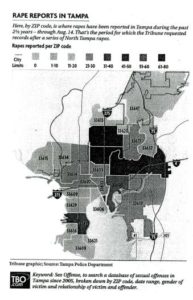A Tribune analysis shows that most sexual assaults are not committed by strangers. Instead, the attackers often are acquaintances, friends, roommates or other people the victims know.

As published in The Tampa Tribune
By Valerie Kalfrin
The Tampa Tribune, Sept. 13, 2007
2008 Florida Press Club Award Winner: Excellence in Crime Reporting
TAMPA — You arrive home after a long day. A shirtless man you’ve never seen ambles down your block. Across the street, your neighbor hops out of his pickup and greets you with a wave.
One of these men might be an attacker — but which one?
Police have warned people to lock their homes because of the rape of a child in Sulphur Springs last month and a string of rapes in North Tampa recently connected through DNA to one suspect. These crimes, each involving an attacker climbing through a window, raise fears about an unknown assailant still on the loose who strikes in the night.
But Tampa police reports reveal a different reality: Sixty-three percent of the 548 people who reported a sex crime within city limits since 2005 said they were attacked by someone they knew. Most often, that someone wasn’t close — not a relative or a romantic partner — but an acquaintance.
This trend is mirrored nationwide, say researchers and advocates who study rape. They suggest using this knowledge to form strategies for reducing your risk of becoming a victim. Hone your intuition, they suggest. Watch for people with controlling behavior. Be assertive.
“The large majority of rapes are acquaintance rape — your plumber, your neighbor, your daughter’s best friend’s father,” said Jennifer Dritt, director of the Florida Coalition Against Sexual Violence in Tallahassee.
“Most people think of stranger rape as ‘real rape.’ It’s the easiest psychologically for people to handle,” Dritt said, “because it’s easy to identify the predatory behavior: He climbs in through the window under cover of night. What they don’t understand is that predators operate all the time.”
It’s About Power, Not Sex
In Tampa, the number of reported sex crimes has dropped since 2005, with 279 reported that year and 93 reported from January to mid August of this year, statistics show. Police attribute this in part to community-oriented policing and the overall drop in the city’s crime rate.
But those numbers show only part of the picture. The Crisis Center of Tampa Bay, which operates a sexual-assault hot line and provides free rape examinations to victims, says the crime seems to be increasing across Hillsborough County. The center performed 289 exams this year through Aug. 31 — 5 percent more than in all of 2006 and 18 percent more than in all of 2005, said Donna Todd, the center’s senior vice president of programs and services.
Thanks to a change in state law effective July 1, some victims who undergo these exams do not have to report a rape, Todd said. The crisis center has examined one woman since July 1 who did not report her attack to law enforcement, she said.
“Most rapes are not about sexuality but about asserting power and control over a victim,” said Susan Lewis, communications director for the National Sexual Violence Resource Center in Enola, Pa. “Part of it has to do with opportunity. … In general, the closer the victim-offender relationship, the less likely they are to report it to the police.”
About 85 percent of rape victims do not report an assault, said David Lisak, an associate professor of psychology at the University of Massachusetts at Boston. Lisak has interviewed convicted rapists as well as college students in his studies and writes that some men who are predators don’t imagine themselves as such. ·
In 2002, Lisak co-published a study of 120 men who admitted to acts that met legal definitions of rape or attempted rape but never were prosecuted. These “undetected rapists” tended to see themselves as good guys when in reality they were adept at testing victims’ boundaries and at using alcohol or violence to accomplish their goals, the study found.
“The cultural narrative of what rape is is completely unrealistic,” said Katie Gentile, an assistant professor of counseling and director of the Women’s Center at John Jay College of Criminal Justice in New York. “I’ve had people ask, ‘If I have sex with someone who’s unconscious, is that rape?’”
 What The Analysis Found
What The Analysis Found
To obtain a large-enough sample for analysis, the Tribune requested information from all reported sex crimes from Jan. 1, 2005, to Aug. 14, 2007 — the date the public records request was completed. There were 548 reports within city limits that police classified as either forcible rape, sexual assault with an object, forcible fondling or forcible sodomy.
Of that number, 345 victims — 63 percent — knew their attackers, the Tribune analysis found. Eighty-four of these cases involved relatives; 28 had had a current or previous romantic relationship with their attackers.
The majority — 233 — were considered acquaintances, cohabitants, friends, neighbors or “otherwise known,” such as a babysitter or day care worker, the data show.
The attackers were considered strangers in 114 of these reports. The relationship was not stated or unknown in 89 reports.
The majority of the victims — 467 — were women or girls; 81 were men or boys. The median age of those attacked was 18, the analysis shows.
There were 227 victims younger than 17. Of those, 177 victims — 78 percent — knew their attackers, the data show. Seventy-five of these cases involved relatives; one had had a current romantic relationship. The majority — 101 — were considered acquaintances, friends, neighbors or “otherwise known,” the data show.
Only 23 in this group were attacked by strangers. In 27 reports, the relationship was unknown or not stated.
Protecting Yourself
Anyone can be vulnerable to an attacker looking for an opportunity, experts say.
With someone familiar to some degree, “your guard is down,” Gentile said. “They might be able to manipulate you with guilt. If it’s a friend of a friend, we think, ‘He knows so-and-so, so he must be OK.’”
Many women are accustomed to making accommodations for personal safety, such as changing their routines to avoid someone unpleasant, Dritt said. Some might chafe at the thought, but it’s an unfortunate necessity, she said.
Kathleen M. Heide, a criminology professor at the University of South Florida, agreed. “One could argue that a woman should have the right to walk along Fletcher Avenue at 2 in the morning to get cigarettes. … Did she do anything wrong? No. … Unfortunately, there are people out there who are opportunists and predators,” Heide said.
Lewis stressed that no rape, regardless of the victim’s behavior, is the victim’s fault. “The only person responsible for rape is the rapist,” she said. You can reduce your risk of attack by being alert and honing your internal radar to potential problems, experts say. For instance, be wary of someone who uses negative, hostile or sexist language; angers easily; or exhibits controlling behavior. Communicate what your limits are for any comments or physical contact that’s too much, such as stroking your hair. If going out with friends, don’t let anyone wander off alone.
Don’t be afraid to listen to your gut. Heide said a woman she knows rode the elevator in her apartment building with a man she had never seen before, even though something about him made her uneasy. The man punched the elevator button for the basement, where he forced her to disrobe. The woman managed to talk him into robbing her instead of raping her, Heide said.
“Women are often raised to be polite, kind and generous and will override their own better sense,” Heide said. “If somebody gives you the creeps, honor it.”
